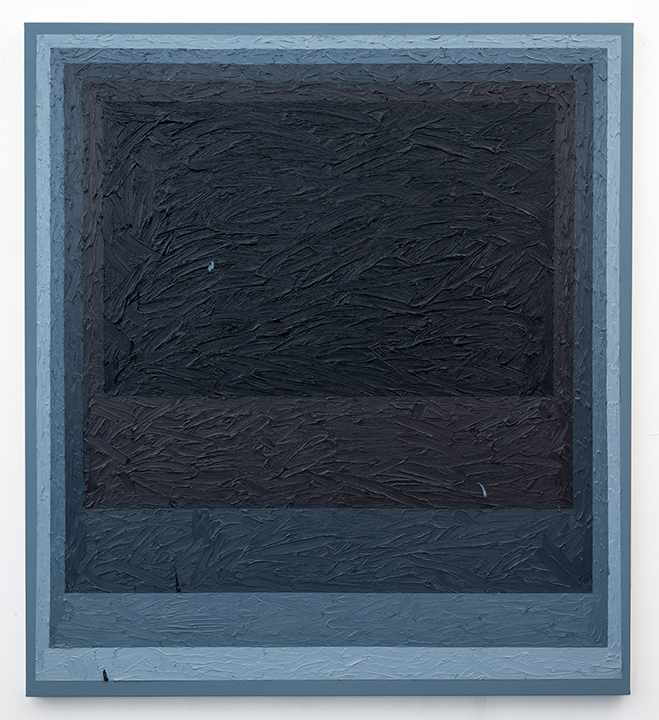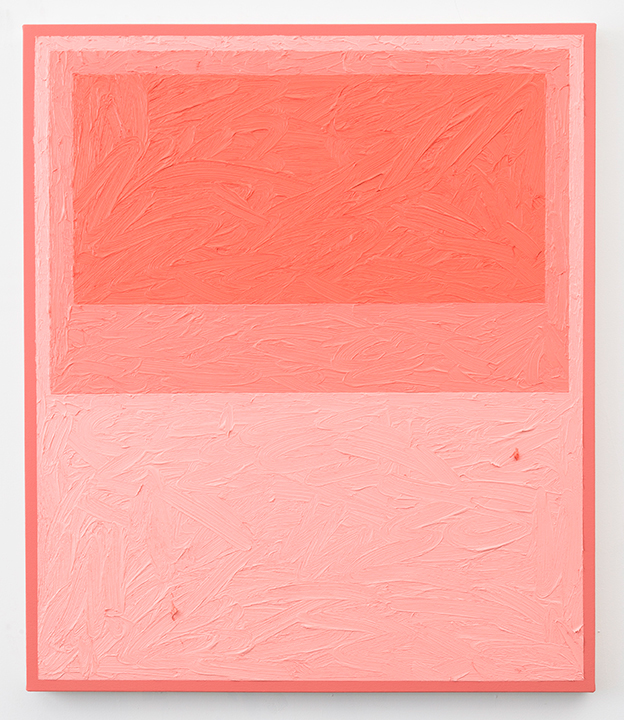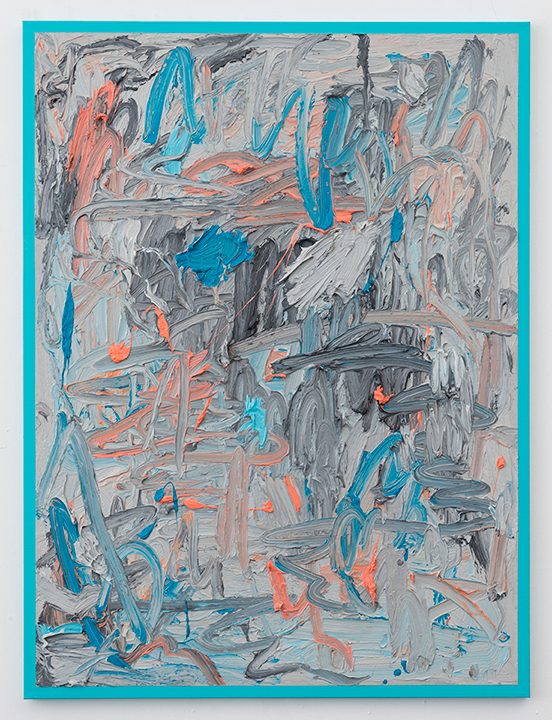RUSSELL TYLER: Radiant Fields
By Jason Stopa, June 3, 2015
DENNY GALLERY | MAY 3 – JUNE 14, 2015
Russell Tyler’s solo show, Radiant Fields, effectively combines three major painterly characterizations of space: the cinematic, the theatrical, and the digital, with surprising result. A brief look at contemporary abstraction reveals similar, but varied, interests. Painters likeade Guyton and Avery Singer reflect the digital impulse. Both artists, to varying degrees, are dedicated to mimicking image-making software techniques and their capacity to flatten and compress information. The theatrical in 20th century painting can be traced back to De Kooning. Barnett Newman’s zips, while abstract in nature, identify with cinematic and narrative space. This is well-traveled territory and finding new ground is difficult; after you get over the virtual-cum-real-novelty of the image, digital space often loses its capacity to take the viewer further than the original tool that generated it. Tyler’s process uses these same digital techniques and incorporates them into previous painting languages, not an easy feat.
Russell Tyler, “GSWS” (2015). Oil on canvas, 60 × 54″. Courtesy of Denny Gallery.
Radiant Fields includes a range of sizes, mostly vertical in format, and each with vivid and subtle color shifts. Works like “GSWS”(2015) feel sensuous and deceptively simple, yet highly organized. Here, Tyler uses a tight-knit framing device of successively smaller, dark rectangles to build the work’s compositional thrust. Each rectangle is painted in thickly impastoed, deep, muddy blues and cool grays, eventually transitioning to black in the upper-half of the canvas. There are shifts in structure as vertical overlapping rectangles give way to horizontal ones. Tyler’s use of gradient color and the rotation of form bring the viewer from periphery to center in an enigmatic, and affecting manner.
Russell Tyler, “3PF” (2015). Oil on canvas, 40 × 34″. Courtesy of Denny Gallery.
The smart installation of the show reinforces Tyler’s interest in contrasts. Near the entrance of the gallery, positioned side-by-side, are “3PF” (2015) and “FTW” (2015). “3PF” is one of the more optimistic works on view. Using a variety of salmon pinks, fluorescent pinks, and fleshly oranges, Tyler simplifies his geometric framing: a thin, fluorescent red-orange rectangular band outlines the painting; inset within is a thickly painted baby-pink rectangle that comprises the remaining canvas. Set inside this form are successively smaller painted rectangles, the smallest of which matches the hue of the first outlining band. There are nuanced optical shifts at work here. The smallest form advances, but its scale and framing simultaneously recess its shape; it hovers in the space, seemingly full and empty. “FTW” contrasts “3PF” in its use of uninhibited touch and all over composition. This work, along with a few others in the gallery, operates according to a different set of rules. Here, Tyler frames the painting with a thin, fluorescent blue band. In the center, he uses dark blue-grays, neon orange-pink and bright cobalt blues painted wet-into-wet. The expressive mark-making is comprised of quick, gestural strokes reminiscent of Philip Guston. By framing up the gesture it acts as parentheses. Quoting the gesture redirects the gesture as self-disclosure, to the gesture as an actor acting in space. It acknowledges the “event” of a painting as always existing within a contained field on a given surface of a certain size.
Russell Tyler, “FTW” (2015). Oil on canvas, 40 × 30″. Courtesy of Denny Gallery.
Radiant Fields presents us with an artist who is capable of moving between painting languages—abstract Expressionism, geometric Abstraction, neo-geo—without being beholden to any of them. Tyler’s use of framing devices is not a French window onto the natural world, but a window onto form. His expressive handling is not entirely theatrical, merely a framed stage. Most convincing, however, is his use of light, which recalls the back-lit emanation on a computer screen, allowing for a graphic reading of the works that situates them within the contemporary moment.
Peter Halley in The Crisis of Geometry famously wrote: “The formalist project in geometry is discredited. It no longer seems possible to explore form as form (in the shape of geometry), as it did to the Constructivists and Neo-Plasticists, nor to empty geometric form of its signifying function, as the Minimalists proposed. To some extent, the viability of these formalist ideas has simply atrophied with time.”* The same could be said of other painting lineages as well. If forward movement in abstraction is to be made, it must go beyond mimicry of the digital, which only points to the banality of mechanization. It must also go beyond recycling geometric and theatrical tendencies. Advancement lies in the intersection between these narratives. Radiant Fields is convincingly in step with the drama of the digital, an arena where tactile information is flattened out, but Tyler reifies this process by bringing the image back into the physical realm to engage with painting as a still-viable dialogue with the capacity to speak to our current moment.
*Halley, Peter. “The Crisis in Geometry.” Published in Arts Magazine, New York Vol. 58, No. 10, June 1984.



